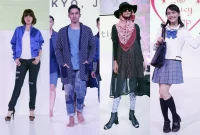Trailblazing Fashion: Innovative Designers Reshaping the Industry. Discover the visionary designers who are pushing boundaries and revolutionizing the fashion world. From avant-garde collections to sustainable practices, these trailblazers are shaping the future of fashion.
Spotlight on Revolutionary Fashion Designers

Trailblazing Fashion: Innovative Designers Reshaping the Industry
In the fast-paced world of fashion, there are certain individuals who rise above the rest with their revolutionary designs. These trailblazing fashion designers are reshaping the industry with their innovative ideas and distinctive styles. Let’s take a closer look at some of these visionary artists:
1. Rei Kawakubo
Rei Kawakubo, the founder of Comme des Garçons, is known for her avant-garde approach to fashion. She challenges traditional notions of beauty and pushes boundaries with her unconventional designs. Kawakubo’s creations often blur the line between clothing and art, leaving audiences in awe of her groundbreaking concepts.
2. Virgil Abloh
Virgil Abloh has rapidly become one of the most influential figures in the fashion industry. As the artistic director of Louis Vuitton Menswear and the founder of Off-White, Abloh has brought a fresh perspective to luxury fashion. He seamlessly combines streetwear aesthetics with high-end couture, embracing the concept of inclusivity and pushing for diversity in the industry.
3. Stella McCartney
Stella McCartney is a renowned advocate for sustainable fashion, pioneering the use of eco-friendly materials in her designs. As a vegetarian, McCartney refuses to use any leather or fur in her collections, making her label an ethical choice for conscious consumers. Her commitment to creating stylish and sustainable clothing has not only positioned her as a leading designer but also as a sustainability ambassador within the industry.
4. Alessandro Michele
Alessandro Michele’s appointment as the creative director of Gucci marked a significant turning point for the iconic brand. Michele introduced a bold and eclectic aesthetic, embracing maximalism and challenging traditional gender norms. His visionary approach to design has breathed new life into Gucci, captivating audiences around the world and redefining what luxury fashion means in the modern era.
These are just a few examples of the revolutionary fashion designers who are reshaping the industry. Their courage to experiment, challenge conventions, and break barriers has redefined the boundaries of fashion and paved the way for future generations of innovative designers.
The Intersection of Art and Fashion
In the dynamic world of fashion, there exists a captivating intersection where art and design converge, giving rise to groundbreaking creations that challenge traditional perspectives. This synergy between art and fashion has been instrumental in reshaping the industry, inspiring innovative designers to push boundaries and create truly extraordinary pieces.
Art has always influenced fashion, and vice versa. Many visionary artists have found a canvas for their artistic expressions in the realm of clothing, making fashion an art form in its own right. Likewise, fashion designers have drawn inspiration from various art movements throughout history, infusing their designs with a sense of creativity and individuality.
From avant-garde runway shows to wearable art installations, the collaboration between artists and fashion designers has sparked a renaissance in the industry. Their unique partnerships have resulted in stunning collections that challenge conventions, blur the lines between fashion and fine art, and captivate audiences with their ingenuity.
One notable example is the collaboration between iconic fashion designer Alexander McQueen and renowned artist Damien Hirst. Their joint effort resulted in the hauntingly beautiful “The Widows of Culloden” collection, where McQueen’s garments showcased Hirst’s butterfly-inspired artwork. This fusion of fashion and art showcased the power to evoke emotions and provoke thoughts, leaving an indelible mark on the industry.
In recent years, emerging designers have also embraced the intersection of art and fashion, using unconventional materials and techniques to create truly boundary-pushing designs. Through the fusion of artistry and wearable aesthetics, they challenge the notion of what fashion should be, making bold statements and redefining societal norms.
This artistic rebellion within the fashion industry pushes the boundaries of creativity, provoking discussions about the larger meanings behind garments and the role of fashion in society. By intertwining artistic elements into fashion, these trailblazing designers are reshaping an industry that demands continuous innovation and distinction.
Sustainable and Ethical Design Philosophies
Sustainable and ethical design philosophies have become increasingly important in the fashion industry, as designers strive to reshape the way clothes are made and consumed. These principles focus on creating fashion that is environmentally friendly, socially conscious, and supports fair labor practices. Here are some key aspects of sustainable and ethical design:
1. Use of Eco-friendly Materials
Designers committed to sustainable practices make conscious choices when selecting materials. They opt for organic, biodegradable, and recycled fibers, such as organic cotton, bamboo, and Tencel. These materials reduce the industry’s reliance on harmful pesticides and synthetic fibers, minimizing the overall environmental impact.
2. Upcycling and Zero-waste Techniques
Instead of discarding textile waste, innovative designers employ upcycling and zero-waste techniques to utilize every inch of fabric. Upcycling involves transforming discarded materials into new garments or accessories, while zero-waste techniques ensure no fabric goes to waste during the production process.
3. Fair Trade and Ethical Production
Sustainable fashion champions fair trade and ethical production practices. This means workers are paid fair wages and work in safe conditions. Additionally, brands in line with these philosophies prioritize transparency and work towards eliminating exploitative labor practices throughout their supply chains.
4. Slow Fashion Movement
Contrary to the fast-paced nature of the mainstream fashion industry, sustainable designers promote the slow fashion movement. They focus on creating high-quality, durable pieces that withstand trends and encourage consumers to invest in timeless garments that can be worn for many years.
5. Circular Economy Approach
Sustainable and ethical designers strive to implement a circular economy approach, where products are designed with the intention of being reused, recycled, or returned to the production cycle. This reduces waste, extends the lifespan of garments, and minimizes the need for new resources.
As the fashion industry evolves, these sustainable and ethical design philosophies pave the way for a more responsible and conscious future. They challenge the traditional norms of the industry and inspire both emerging and established designers to reshape their practices for the better.
Emerging Trends in Fashion Design
The world of fashion design is constantly evolving, driven by the creativity and innovation of trailblazing designers. These designers are reshaping the industry with their unique and groundbreaking ideas, setting new trends and pushing boundaries. Here are some of the emerging trends that are taking the fashion world by storm:
-
Minimalism
Simplicity is the new black. Minimalistic designs with clean lines and neutral color palettes are becoming increasingly popular. Designers are focusing on timeless pieces that are versatile, sustainable, and can be worn for multiple occasions.
-
Gender Fluidity
Gender norms are being challenged by designers who are embracing androgyny in their collections. The blurring of gender lines is evident through the use of unisex clothing, diverse models, and inclusive designs that break away from traditional stereotypes.
-
Technology Integration
The fashion industry is embracing technology like never before. Designers are incorporating wearable tech, 3D printing, and smart fabrics into their creations, creating innovative and functional garments that not only look fabulous but also provide unique experiences for the wearer.
-
Sustainability
With growing awareness of environmental issues, sustainable fashion has become a major trend. Designers are using eco-friendly materials, adopting ethical production processes, and promoting slow fashion to reduce waste and the negative impact on the planet.
These emerging trends in fashion design are shaping the industry, offering exciting new possibilities and challenging the status quo. As designers continue to push boundaries and think outside the box, we can expect even more groundbreaking innovations to transform the way we perceive and embrace fashion.
The Influence of Cultural Diversity
In today’s globalized world, cultural diversity plays a significant role in shaping various aspects of society. This is particularly evident in the fashion industry. Trailblazing designers from diverse cultural backgrounds have been making their mark by introducing innovative and unique designs that challenge traditional norms and reshape the industry in exciting ways.
One way cultural diversity has influenced fashion is through the incorporation of traditional elements from different cultures into contemporary designs. Designers are drawing inspiration from ethnic patterns, textiles, and craftsmanship techniques, infusing them into their collections. This not only celebrates cultural richness but also introduces fresh aesthetics to the fashion landscape.
Furthermore, the influence of cultural diversity extends beyond aesthetics. It also sparks conversations about social issues, inclusivity, and representation. Many designers are using their platforms to address societal topics, advocating for inclusivity and embracing diverse body types, genders, and ethnicities. By challenging mainstream beauty standards, these design visionaries are shaping a more inclusive and accepting industry.
Collaborations between designers from different cultural backgrounds have also become increasingly common. These collaborations bring together diverse perspectives, skills, and experiences, resulting in groundbreaking designs that fuse elements from multiple cultures. These collaborations not only showcase the beauty of cultural exchange but also open up new possibilities for cross-cultural creativity and innovation.
As the fashion industry continues to evolve, the influence of cultural diversity remains a driving force behind its transformation. Trailblazing designers are breaking barriers, challenging norms, and reshaping the industry to reflect our diverse world. Their innovative designs, rooted in cultural diversity, have the power to inspire and ignite meaningful change, making fashion a powerful tool for cultural exchange and understanding.
The Future of Fashion in a Digital World
Rapid advancements in technology have brought about a paradigm shift in the fashion industry, giving rise to an exciting new era. As designers embrace digital innovation, the future of fashion is being reshaped by trailblazing individuals who are pushing boundaries and challenging traditional norms.
One of the key areas where technology is making a significant impact is in the design process itself. With the advent of computer-aided design (CAD) software, fashion designers are able to create intricate and detailed designs with greater precision and efficiency. This not only speeds up the production process but also allows for more experimentation and creativity.
Furthermore, the rise of 3D printing has revolutionized the way fashion prototypes are produced. Designers can now bring their concepts to life within hours, eliminating the need for costly and time-consuming manufacturing processes. This not only reduces waste but also opens up possibilities for more sustainable fashion practices.
The digital world has also transformed the way fashion is marketed and consumed. Social media platforms have become powerful tools for designers to connect with their audience and promote their creations. Through captivating visuals and engaging storytelling, fashion brands can now reach a global audience in an instant, bypassing traditional gatekeepers.
Additionally, the rise of e-commerce has disrupted the traditional brick-and-mortar retail model. Online shopping platforms have democratized access to fashion, allowing independent designers to showcase their collections alongside established brands. This has led to a more diverse and inclusive fashion landscape, where unique voices and perspectives can thrive.
Looking forward, the future of fashion in a digital world holds even more exciting possibilities. From virtual reality fashion shows to smart fabrics that integrate technology, designers are continuously pushing the boundaries of what is possible. The digital revolution is not only shaping the way we dress but also challenging us to redefine our relationship with fashion.
Conclusion
Innovative designers are reshaping the fashion industry with their trailblazing ideas and designs. Their commitment to pushing boundaries and challenging traditional norms has given rise to a new era of creativity and inclusivity. As they continue to experiment with sustainable materials, diverse representations, and cutting-edge technologies, fashion is evolving into a powerful platform for self-expression and social change.



